Last updated on April 20, 2024
You have your Deluxe Backgammon set, you know how to set it up for play and you understand the basic rules, strategies and tactics. To take your game to the next level so you can truly enjoy using your luxury backgammon set, you need to understand the opening rolls. In this guide, we will explain the accepted opening rolls and discuss some of the alternatives. A complete list of Playing Guides is available on this link. A simple list of the backgammon opening rolls is available on this link.
In normal play, there are 36 possible combinations for the roll of two six-sided dice. If we exclude duplicate values, such as 1-2 and 2-1, there are 21 possible combinations for each turn of play. However, in the backgammon opening rolls, this is reduced to 15 possible combinations as doubles are excluded. We use the standard 24-point notation system to explain the moves. Where there is no alternative it is because the opening move is considered to be the only correct option.
Note: The term rollout refers to a technique for evaluating backgammon positions and moves. The position is played many times over with many different rolls and the results are recorded. The balance of wins versus losses can then be used to determine the move most likely to bring victory. Rollouts were once performed by hand, but are now generated by powerful computer programs. There is a slight statistical advantage to the player going first.
Opening Roll: 2-1
Opening Move 13/11, 6/5 Alternative 24/23, 13/11
13/11, 6/5 is an offensive backgammon play. By slotting your 11, and particularly your 5-point, you create opportunities to secure points on your next move. However, some players may be reluctant to leave a blot within direct range of a hit, but early in the game is the time to take the risk as there is plenty of time to recover. There is a 42% chance of the 5-point being hit, but a 78% chance of being able to cover the blot on the next roll. This is an opening gamble that seems risky, but can pay off statistically. If your checker is hit, there is time to recover.
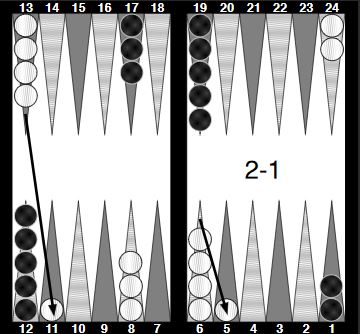
24/23, 13/11 is a splitting play that brings a builder into your opponent’s outer board and broadens the coverage of your opponent’s home board for building an advanced anchor. The opponent will be more likely to be trying to secure points in their home board rather than hitting the solo checkers. In addition, this also makes it slightly more dangerous for your opponent to slot their 5-point.

Either option is viable, although the 13/11, 6/5, comes out slightly in front on the rollout.
Opening Roll: 3-1
Opening Move 8/5, 6/5
Beginners might be surprised to learn that 3-1 is the best of the opening rolls in backgammon. However, the experts all unanimously agree that this is the only viable move for this roll. This is because this move secures your 5 point, which is the single most important piece of real estate on your side of the board. It closes down a valuable landing space for your opponent when returning checkers from the bar. With additional checkers on board, it is a secure platform for creating points deeper in your home board. Additionally, it creates a perfect starting point for building a prime.

Opening Roll: 3-2
Opening Move 13/10, 13/11 Alternative 24/21, 13/11
13/10, 13/11 is an offensive play designed to bring two builders down to the outer board with a strong chance of creating a blocking point on the next turn. However, there is some risk with this move because your opponent has a 19% chance of making a roll that will allow a hit on their turn. If you are not hit then you should be able to start building a barrier before your opponent can free their back checkers.

24/21, 13/11 is another popular way to play the 3-2. The 24/21 moves one of the back checkers forward, where if it doesn’t get hit, provides an opportunity to create an advanced anchor on a subsequent move. The 13/11 brings a builder down to a relatively safe position where it can be used in the next move to create a point.
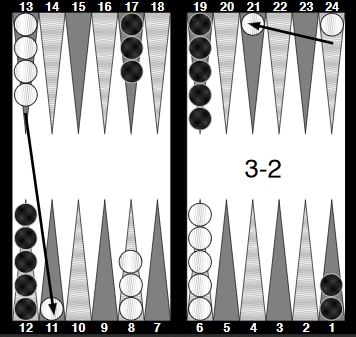
On the rollout, these two options have almost identical results. Make the play you feel most comfortable with.
Opening Roll: 4-1
Opening Move 24/23, 13/9 Alternative 13/9, 6/5
24/23,13/9 is the most popular way to play the 4-1. The 13/9 moves a builder down to the outer board which can be used to create a blocking point on future rolls. The 24/23 splits the back pair and broadens the coverage of your opponent’s home board for building an advanced anchor. The opponent will be more likely to be trying to secure points in their home board rather than hitting the loose checkers. This also makes it slightly more dangerous for your opponent to slot their 5-point.
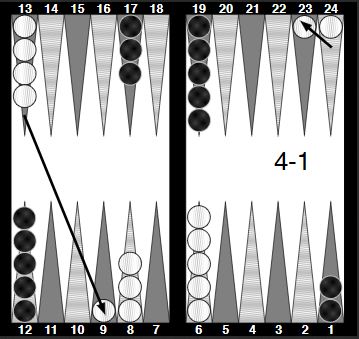
The alternative play, 13/9, 6/5, is a slightly riskier option, slotting two checkers within striking range of your opponent. Obviously, you are trying to secure the 5-point on the next roll, but this assumes you are not hit beforehand. However, if the risk pays off it is a handsome reward for a daring move. Otherwise, it could mean the first of many trips to the bar.

Opening Roll: 4-2
Opening Move 8/4, 6/4
4-2 is the second-best opening roll in Backgammon. There is only one way to play this roll, which is to secure the 4-point. Although not as good as securing the 5-point, it locks down a home board point. This has a blocking effect on your opponent’s checkers and makes it more difficult for them to re-enter if hit. In addition, the 4-point provides the framework for forming a prime and takes a checker off the heavily stacked 6-point.

Opening Roll: 4-3
Opening Move 24/21, 13/9 Alternative 13/10, 13/9
There are a number of reasonable moves to consider for a 4-3, however, we will just look at two of the best based on the results of the XG Mobile Backgammon rollout. The 24/21,13/9 splits the back checkers and brings down a builder that can be used to form points further along the board on subsequent rolls. This is useful for creating a quick barrier for your opponent’s back checkers. However, the blots are at risk of being hit if your opponent rolls high on their next throw.
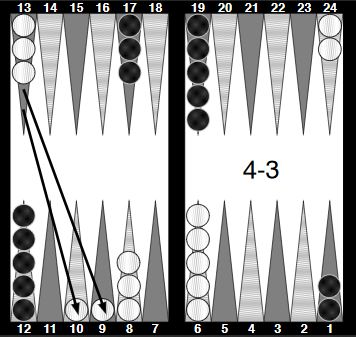
The 24/21,13/9 brings down the builder to the 9-point and splits the back pair. The 9-point can be used to form a point on the next throw. The split back pair can be used to form an advanced anchor in your opponent’s home board.

The 13/10, 13/9 has slightly better results on the rollout.
Opening Roll: 5-1
Opening Move 24/23, 13/8 Alternative 13/8, 6/5
The key with this roll is to decide where you want to slot the 1. In the preferred option you split your back checkers, leaving them relatively unlikely to be hit, but in position to form an advanced anchor. Next, you use the 5 to move a checker to the 8-point. This can be used as a spare builder or to hit advancing checkers on subsequent moves.

The alternative roll is slightly riskier because it slots the 5-point. This is highly unlikely to be ignored by your opponent. Consequently, they will hit this blot if the opportunity arises. However, if the blot is missed you may be able to secure the 5-point on the next roll. The 5 is used to bring a spare checker to the 8-point.
Opening Roll: 5-2
Opening Move 24/22, 13/8 Alternative 13/11, 13/8
The 24/22, 13/8 roll has the best results based on the rollout. It splits the back pair, leaving them relatively unlikely to be hit, but in position to form an advanced anchor. Next, you use the 5 to move a checker to the 8-point. This can be used as a spare builder or to hit advancing checkers on subsequent moves. However, there is one risk with this move and that is if your opponent rolls double 5 on their next turn. This would result in them claiming their 1 and 3 points and leaving you with two checkers on the bar. There is a 1/36 chance of this happening and the rollouts suggest that if you can get past this obstacle then this is the best opening move.

The 13/11, 13/8 move is slightly more conservative. The 13/11 brings a builder into play, which is deep enough in the board that it is unlikely to be hit. It can be used on subsequent plays to secure a point. The 13/8 can be used as a spare builder or to hit advancing checkers on subsequent moves.
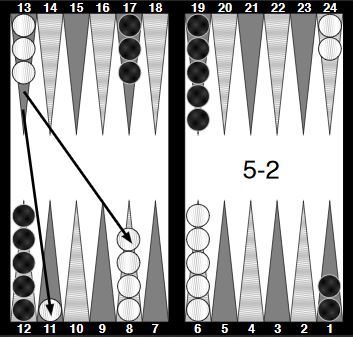
Opening Roll: 5-3
Opening Move 8/3, 6/3
The 8/3, 6/3 is by far the best move according to the rollout results. It is completely safe, secures a home point and removes a checker from the heavily stacked 6-point. In years gone by it was assumed that this was too early in the game to bring checkers this far forward and that they could be better used elsewhere. Computer rollouts have confirmed that the 8/3, 6/3 is the only move that should be considered for this roll.

Opening Roll: 5-4
Opening Move 24/20, 13/8 Alternative 13/9, 13/8
24/20, 13/8 is the best option for this roll. It’s a balanced play, creating opportunities on both sides of the board. However, the risk here is that the blot on your opponent’s 5-point will be a target. Though, if you are not hit and you roll a 4 on your next turn you will secure the 5-point in your opponent’s home board. This is a premium position that will cause problems for your opponent. The 13/8 can be used as a spare builder or to hit advancing checkers on subsequent moves.

The 13/9, 13/8 option brings two builders into play. These can be used to secure points on subsequent throws or to attack loose blots. The downside is that it brings too many checkers forward on the board and only leaves one spare on the mid-point. It takes away some of the flexibility around the mid-point of the board because there are too few checkers.
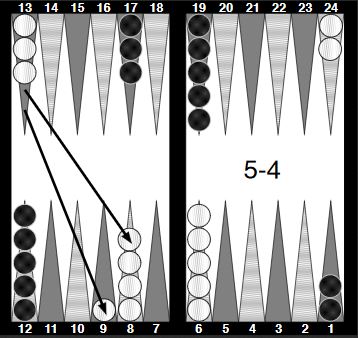
Opening Roll: 6-1
Opening Move 13/7, 8/7
The 6-1 is the third-best opening roll in backgammon. There is only one reasonable way to play this roll, which is to secure your bar-point. Although not as valuable as a home board point, the bar-point is still a useful point to hold. Additionally, it fills the gap between the 8 and 6-points, which forms a strong blocking formation.

Opening Roll: 6-2
Opening Move 24/18, 13/11 Alternative 13/7, 7/5
The 24/18, 13/11 is by far the most popular move for this roll. This is because it tries to advance checkers on both sides of the board. The 24/18 splits the back checkers and leaves a blot on your opponent’s bar point. The aim here, assuming you don’t get hit, is to secure the bar point on the next roll or to run the checker forward. The 13/11 brings a builder into play, which is deep enough in the board that it is unlikely to be hit. It can be used on subsequent plays to secure a point.

The 13/7, 7/5 is an extremely risky move leaving a blot on your 5-point. However, this is not likely to go unnoticed by your opponent and as a result, it will be hit if the opportunity arises. Regardless, if you don’t get hit and you can secure the 5-point on the next roll the risk has paid off.
Opening Roll: 6-3
Opening Move 24/18, 13/10 Alternative 24/21, 21/15
The 24/18, 13/10 is by far the most popular move for this roll. This is because it tries to advance checkers on both sides of the board. The 24-18 splits the back checkers and leaves a blot on your opponent’s bar point. The aim here, assuming you don’t get hit, is to secure the bar point on the next move or to run the checker forward. The 13/10 brings a builder into play. As a result, it is available in subsequent plays to secure a point.

The 24/21, 21/15 move is risky. It is a running play where you plan to advance the same piece forward on the next roll. The problem is that your opponent has a 36% chance of having the opportunity to hit on their next move. This will set you back in the race by 9 pips, but if the blot is missed then the risk pays off.
Opening Roll: 6-4
Opening Move 24/14 Alternative 24/18, 13/9 or 8/2, 6/2
The rollout indicates that the 24/14 is the marginally better move, but the results are so tight that any of the three options is acceptable. There may also be other options to consider. The 24/14 move takes the running option. It isn’t as good as the Lover’s Leap as it falls just short of the safety of the mid-point. The hope with this move is that the blot on the 14-point won’t get hit and you will move it to safety on the next roll.
The 24/18 splits the back checkers and leaves a blot on your opponent’s bar-point. The aim here, assuming you don’t get hit, is to secure the bar-point on the next move or to run the checker forward. The 13/9 brings a builder into play. As a result, it can be used in subsequent plays to secure a point.
The 8/2, 6/2 move secures the 2-point in your home board. Some would argue that the point is too far forward in the board to be of use early in the game. Furthermore, it also takes two checkers out of play which could be more useful if held back.

Opening Roll: 6-5
Opening Move 24/18, 18/13
24/18, 18/13 is known as the Lovers Leap. It advances one of the back checkers all the way forward to a safe position on your mid-point. The experts and the rollouts confirm that this is the only viable option for this roll.
Related content
Read about the general principles for replying to these backgammon opening rolls.
Wikipedia – Backgammon opening theory.
The 5 best opening rolls in backgammon.

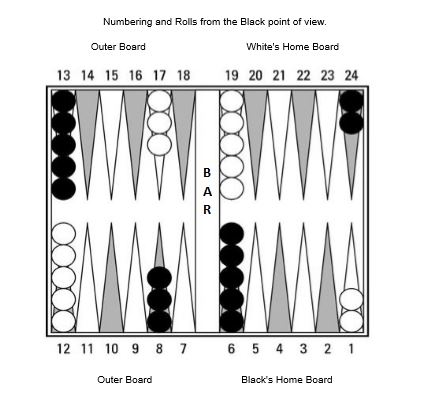
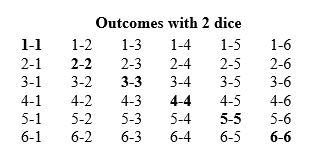

Well explained backgammon openings thanks
Below “Opening Roll: 6-2”, the sentence “The 13/8 can be used as a spare builder or to hit advancing checkers on subsequent moves.” seems to be a copy&paste error.
Hi Magnus, well spotted, it is indeed a cut & paste error, which has been updated. Thanks for pointing that out. Deluxe Backgammon appreciates the feedback. We hope this improves our backgammon opening moves guide. Thanks again, Jason